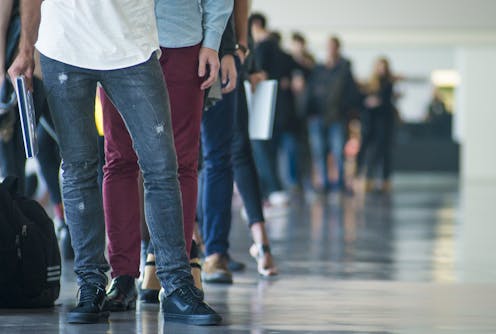The budget couldn’t include every ‘good idea’ but not boosting JobSeeker and the Youth Allowance were obvious misses
- Written by Cassandra Goldie, Adjunct Professor and UNSW Law Advisory Council Member, UNSW Sydney

The government says the budget will help people doing it tough. But it has also opted not to increase JobSeeker[1] and Youth Allowance[2], despite expert advice these payments should be the highest priority in a cost-of-living crisis.
At the same time, monetary policy is driving up unemployment to cut inflation, which is expected to put 100,000 more people out of paid work.
Despite correctly diagnosing the problems with the economy, the budget fails to deliver the solutions that are arguably needed most.
Instead, it tinkers at the edges while ignoring the gaping hole in Australia’s safety net. Genuine repair requires a substantial boost to the incomes of more than a million people who are trying to survive on JobSeeker, Youth Allowance and related payments of $55 or less a day.
The combined effect of the budget’s major “cost-of-living measures”, including the tax cuts, will deliver a $6-a-week increase to a single person relying on JobSeeker (or $15 for the minority who are eligible for rent assistance). Meanwhile, a single person earning $200,000 a year will receive an extra $93 a week.
Before each of the past two budgets, the government’s own Economic Inclusion Advisory Committee[3] (of which I am a member) urged it to prioritise a big increase in JobSeeker, Youth Allowance and related payments. It made a small ($20 a week) increase in last year’s budget and there was none in this one.
This body, comprised of economists, social security experts, advocates, community service organisations, unions and business organisations, has been clear about its priorities, informed by rigorous research and analysis. First, lift JobSeeker by a substantial amount. Second, boost Commonwealth Rent Assistance[4].
The rent assistance increase in the budget is limited: it only helps a minority of people on the very lowest incomes, and is so modest it won’t lift people out of rental stress.
The increase will provide up to $9.40 extra a week for a single person getting the maximum rate of rent assistance. However, most people receiving JobSeeker and Youth Allowance do not receive rent assistance – and if they do, they’re likely to remain in deep housing stress. A single student paying median rent of $220 a week will continue to pay more than half their income support in rent alone because the Youth Allowance is so low.
The budeget’s changes to the Carer Payment[5] will make it easier for people to take up paid work without being penalised.
Also welcome is money for homelessness services, Aboriginal family violence prevention services, the creation of 3,000 jobs in remote communities[6] and help for Services Australia to reduce the shocking claims backlog. There are positive signals regarding employment services reform. But the automated payment suspensions still need to be fixed.
Handing $300 in energy bill relief[7] to all households – regardless of income – is wasteful and fails to target those who most need help.
While billions are being pumped into renewables to deal with the climate crisis, people on low incomes are being left behind by the energy transition.
Wealthier homeowners may be able to switch to efficient appliances and rooftop solar, but renters on low incomes are stuck in inefficient homes that cost thousands each year to heat and cool.
Before the budget, the government tried to sideline the push to raise the rate of JobSeeker — from advocates receiving income support, leading economists and women’s safety experts – as worthy but unrealistic. In the government’s dismissal of the economic advisory committee’s report, it said it was not able to adopt every “good idea” in the budget.
Making sure people have enough money to eat three times a day is not a “good idea”. It is a basic responsibility of government. While finding a way to deliver $26 billion in tax cuts[8], including $4,500 extra a year to people on $200,000, the government hasn’t meaningfully raised the living standards of those most in need. The 2024–25 surplus is about the equivalent of lifting JobSeeker and related payments to the pension rate of $80 a day.
Of the more than one million people currently relying on JobSeeker and related payments, only 4,700 will receive an increase in their base rate. Those eligible have “partial capacity” to work, fewer than 14 hours a week, and will receive an extra $27.50 a week. Arguably, this group should have access to the higher Disability Support Pension[10] anyway.
The Economic Inclusion Advisory Committee found that significantly raising the JobSeeker rate to 90% of the Age Pension[11], or $72 a day, would have a “small to negligible” effect on inflation. At $4.6 billion a year, the cost would represent a tiny fraction of GDP – 0.16% – or just 0.43% of total household spending.
Forcing people to live on incomes so low they eat one meal a day, go without medicine or freeze during winter will not help fight inflation. Inflation is being driven by people with cash to spare on restaurants, holidays and other discretionary spending.
The government insists it is serious about bolstering living standards, economic security and solving the housing crisis. Yet it has failed to provide targeted and long-term relief for the people who need it the most.
References
- ^ JobSeeker (www.servicesaustralia.gov.au)
- ^ Youth Allowance (www.servicesaustralia.gov.au)
- ^ Economic Inclusion Advisory Committee (www.dss.gov.au)
- ^ Commonwealth Rent Assistance (www.dss.gov.au)
- ^ Carer Payment (www.servicesaustralia.gov.au)
- ^ 3,000 jobs in remote communities (www.9news.com.au)
- ^ $300 in energy bill relief (minister.dcceew.gov.au)
- ^ tax cuts (treasury.gov.au)
- ^ Mick Tsikas/AAP (photos.aap.com.au)
- ^ Disability Support Pension (www.servicesaustralia.gov.au)
- ^ Age Pension (www.servicesaustralia.gov.au)
Authors: Cassandra Goldie, Adjunct Professor and UNSW Law Advisory Council Member, UNSW Sydney







